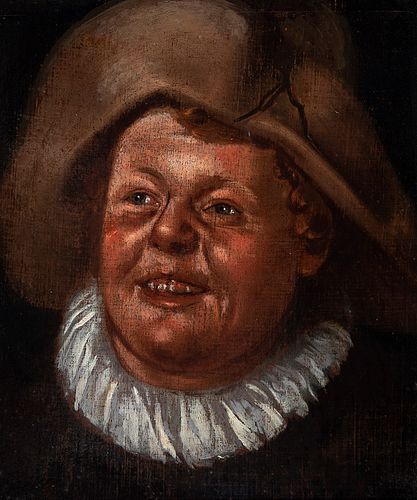Modelled on ADRIAEN BROUWER (Belgium, 1605 - 1638). 20th century. "Man. Oil on canvas. Size: 33 x 28 cm; 52 x 47 cm (frame).
Lot 128
About Seller
Setdart Auction House
Carrer Aragó 346
Barcelona
Spain
Setdart Subastas was born in 2004 and is currently the first online art auction in Spain with solidity, prestige and reliability guaranteed by our more than 60,000 users. Setdart has a young, dynamic and enterprising team ready to successfully manage the purchase and sale of art works through custom...Read more
Estimate:
EUR€1,000 - EUR€1,200
$1,075.27 - $1,290.32
Absentee vs Live bid
Two ways to bid:
- Leave a max absentee bid and the platform will bid on your behalf up to your maximum bid during the live auction.
- Bid live during the auction and your bids will be submitted real-time to the auctioneer.
Bid Increments
| Price | Bid Increment |
|---|---|
| EUR€0 | EUR€10 |
| EUR€200 | EUR€25 |
| EUR€500 | EUR€50 |
| EUR€1,000 | EUR€100 |
| EUR€3,000 | EUR€200 |
| EUR€5,000 | EUR€500 |
| EUR€10,000 | EUR€1,000 |
| EUR€20,000 | EUR€2,000 |
| EUR€50,000 | EUR€5,000 |
About Auction
By Setdart Auction House
Oct 20, 2021
Set Reminder
2021-10-20 07:30:00
2021-10-20 07:30:00
America/New_York
Bidsquare
Bidsquare : OLD MASTERS
https://www.bidsquare.com/auctions/setdart-auction-house/old-masters-7700
Setdart Auction House sofia@setdart.com
Setdart Auction House sofia@setdart.com
- Lot Description
Modelled on ADRIAEN BROUWER (Belgium, 1605 - 1638). 20th century. "Man. Oil on canvas. Size: 33 x 28 cm; 52 x 47 cm (frame). Male portrait in which the protagonist is shown facing the spectator, with his face slightly turned to the left. Against a neutral background that monumentalises the figure of the young man, the artist reveals very few details of the sitter. A cap and a hat stand out against the austerity of the painting. The psychological aspect of the work, defined by his mischievous look accentuated by his smile, is given greater prominence. These characteristics are very much reminiscent of Boewer's painting. Brouwer trained in Holland in the studio of Frans Hals. However, conflicts with his master led the young man to flee to Amsterdam, finally settling permanently in Antwerp in 1931, where he died prematurely only seven years later. Between 1631 and 1632 he became a teacher at the Guild of Saint Luke in Antwerp. Despite his short career, Brouwer was the creator of a new genre of genre within genre painting, namely tavern scenes. His works were chiefly small-format and generally depicted popular, low-life characters, usually drunkards, with a certain violence in their attitudes and behaviour. This type of image allowed Brouwer to experiment with capturing emotions and expressions of pain, fear and other feelings, revealing an interest in human aspects that went beyond the traditional conception of genre painting. Despite his legal and financial problems, Brouwer was a respected painter during his lifetime and in fact both Rubens and Rembrandt acquired some of his works. Today works by Adriaen Brouwer are housed in leading art galleries around the world, including the Louvre in Paris, the Hermitage in St. Petersburg, the Prado in Madrid, the Alte Pinakothek in Munich, the National Gallery in London, the Smithsonian in Washington D.C., the Kunstmuseum in Basel and the Ashmolean in Oxford.
- Shipping Info
-
In-house shipping available. Please inquire at admin@setdart.com.
-
- Buyer's Premium



 EUR
EUR CAD
CAD AUD
AUD GBP
GBP MXN
MXN HKD
HKD CNY
CNY MYR
MYR SEK
SEK SGD
SGD CHF
CHF THB
THB





